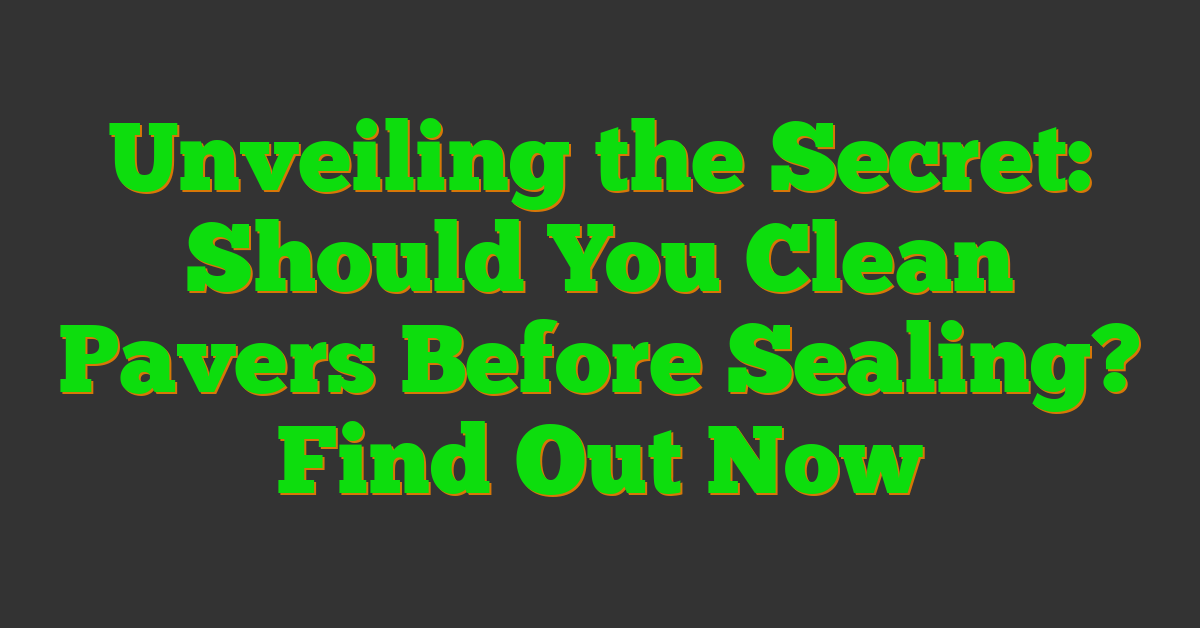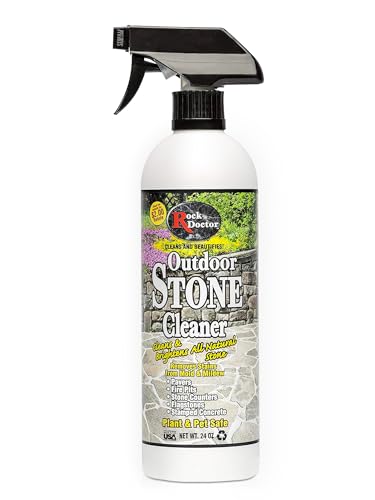Considering sealing your pavers? Before diving into the process, it’s crucial to address a key question: do you need to clean the pavers before sealing? The answer may surprise you. Cleaning pavers before sealing is not just a good practice; it’s essential for achieving long-lasting results.

By cleaning the pavers thoroughly, we ensure that the surface is free from dirt, grime, and other contaminants that could interfere with the sealing process. This preparation step not only enhances the aesthetic appeal but also allows the sealant to adhere effectively, providing better protection against stains, weathering, and wear over time.
In this article, we’ll explore the importance of cleaning pavers before sealing and delve into the benefits it offers. Let’s discover why this initial step is a crucial part of the paver sealing process.
Importance of Cleaning Pavers Before Sealing
As landscape designers, we understand the pivotal role that cleaning pavers before sealing plays in ensuring the longevity and aesthetics of outdoor spaces.
The Role of a Clean Surface
When it comes to sealing pavers, a clean surface serves as the fundamental foundation for a successful sealing process. By meticulously cleaning the pavers, we eliminate any dirt, grime, or organic matter that could interfere with the adhesion of the sealant. This clean surface allows the sealant to bond effectively with the pavers, forming a strong protective barrier against unwanted stains, harsh weather conditions, and gradual wear and tear.
Potential Issues with Unclean Pavers
Neglecting to clean pavers before sealing can lead to a myriad of issues that compromise the overall quality and durability of the sealed surface. Unclean pavers not only hinder the proper adherence of the sealant but also trap contaminants beneath the sealant layer. This trapped debris can result in unsightly discoloration, mold growth, and even premature sealant failure. By overlooking the crucial step of cleaning pavers, we risk undermining the effectiveness of the sealing process and diminishing the visual appeal and resilience of the outdoor space.
Assessing Your Pavers for Sealing
As landscape designers, assessing your pavers before sealing is pivotal to achieving the desired visual appeal and longevity of your outdoor spaces. Proper evaluation ensures that the sealing process protects your pavers effectively, maintaining their integrity and aesthetics over time.
Signs Your Pavers Need Cleaning
When determining whether your pavers require cleaning before sealing, several signs can indicate the necessity of this preparatory step:
- Stains and Discoloration: Noticeable stains or discoloration on the surface of your pavers suggest the presence of contaminants that need to be removed before sealing.
- Weeds and Moss Growth: The growth of weeds, moss, or other vegetation between the pavers indicates the accumulation of organic matter that should be cleaned to prevent future issues.
- Surface Debris: Build-up of dirt, grime, or debris on the pavers not only detracts from their appearance but also interferes with the proper adhesion of the sealant.
- Mold or Mildew: The presence of mold or mildew on the pavers not only affects their visual appeal but can also lead to structural damage if left unchecked.
By identifying these signs, we can ascertain the need for cleaning the pavers before proceeding with the sealing process.
Pre-Sealing Inspection Checklist
To ensure thorough preparation for sealing your pavers, follow this pre-sealing inspection checklist:
- Clear Debris: Remove any leaves, twigs, dirt, or other debris from the paver surface to facilitate a clean and smooth sealing process.
- Perform a Deep Clean: Use a pressure washer or appropriate cleaning solution to eliminate tough stains, mold, mildew, and embedded dirt from the pavers.
- Inspect for Damage: Check for any cracks, chips, or uneven areas on the pavers that may require repair before sealing to maintain structural integrity.
- Allow Drying Time: After cleaning, allow the pavers to dry completely before applying the sealant to ensure optimal adhesion and longevity of the sealing.
By adhering to this checklist, we can ensure that the pavers are in prime condition for sealing, guaranteeing optimal protection and enhancement of outdoor spaces.
The Cleaning Process Explained
Manual Cleaning vs. Pressure Washing
When it comes to cleaning pavers before sealing, we recommend considering manual cleaning versus pressure washing. Manual cleaning involves using a stiff brush or scraper to remove dirt, stains, and debris from the surface of the pavers. This method allows for more precise cleaning, especially in delicate areas where pressure washing might be too harsh. On the other hand, pressure washing uses a high-pressure stream of water to blast away dirt and grime quickly. While pressure washing can be efficient, it may not be suitable for all types of pavers, as it can damage or erode the surface if not done correctly. We always assess the condition of the pavers and choose the most appropriate cleaning method to ensure optimal results.
Preparing Your Cleaning Solutions
Before starting the cleaning process, it’s essential to prepare the right cleaning solutions for the job. We typically recommend using a mixture of water and a mild detergent or a commercially available paver cleaner. These solutions help loosen dirt and stains, making it easier to remove them during the cleaning process. Additionally, for tougher stains like oil or grease, we may suggest using a specialized cleaner designed for pavers. It’s crucial to follow the manufacturer’s instructions when mixing and applying cleaning solutions to avoid damaging the pavers.
Step-by-Step Cleaning Guide
To effectively clean pavers before sealing, we follow a step-by-step cleaning guide to ensure thorough and proper maintenance of the outdoor space:
- Clear Debris: Begin by removing any surface debris, such as leaves, twigs, and loose dirt, from the pavers. This initial step helps prevent debris from interfering with the cleaning process and ensures a clean surface to work on.
- Deep Cleaning: Depending on the level of dirt and stains present, deep cleaning may involve manual scrubbing with a brush, applying a cleaning solution, or using a pressure washer. We pay special attention to heavily stained areas and take care not to damage the paver surface during cleaning.
- Inspect for Damage: While cleaning, we carefully inspect the pavers for any signs of damage, such as cracks, chips, or uneven surfaces. Identifying and addressing damage before sealing is crucial to maintaining the structural integrity of the paved area.
- Allow Drying Time: After cleaning, we allow the pavers to dry completely before proceeding with the sealing process. Proper drying ensures that the pavers are free from moisture, allowing the sealant to adhere effectively and provide long-lasting protection.
By following these steps, we ensure that the pavers are thoroughly cleaned and prepared for sealing, enhancing their durability and visual appeal in outdoor spaces.
Choosing the Right Sealant for Your Pavers
Types of Paver Sealants
When looking to seal your pavers, it’s essential to understand the different types of sealants available in the market. There are primarily two main categories: film-forming sealants and penetrating sealants.
Film-forming sealants create a protective layer on the surface of the pavers, offering enhanced durability and a glossy finish. These sealants can help repel water, oil, and stains, making maintenance easier. However, they may change the appearance of the pavers by adding a sheen.
On the other hand, penetrating sealants are absorbed into the pavers, providing protection from within. They offer a more natural look as they don’t alter the appearance of the pavers significantly. Penetrating sealants are ideal for areas where a matte finish is preferred and can protect against moisture and mold growth.
Factors to Consider When Selecting a Sealant
When choosing a sealant for your pavers, there are several factors to take into consideration to ensure you make the right decision for your outdoor space.
« Unveiling the Ultimate Guide to Prevent Pavers from Sinking – Say Goodbye to Flooding Surfaces Now Pavers vs. Decks: Find Out Which Will Save You $$$! The Ultimate Cost Comparison »
Paver Type: Consider the material of your pavers, whether they are concrete, brick, or natural stone. Different sealants work better with specific paver materials.
Finish: Determine the desired finish for your pavers. Whether you prefer a glossy look or a natural matte appearance, selecting the appropriate sealant can help achieve the desired outcome.
Durability: Evaluate the level of protection needed based on the pavers’ location and exposure to elements like sun, rain, and foot traffic. A more durable sealant may be required for high-traffic areas.
Maintenance: Consider the maintenance requirements of the sealant. Some sealants may need reapplication more frequently than others, so choose one that aligns with your maintenance preferences.
Environmental Impact: Look for sealants that are environmentally friendly and safe for outdoor use. Consider the impact on vegetation and water sources when selecting a sealant for your pavers.
By considering these factors and understanding the types of sealants available, you can make an informed decision when choosing the right sealant for your pavers, ensuring they are well-protected and maintain their aesthetic appeal for years to come.
Applying the Sealant for Long-Lasting Results
As landscape designers, we understand the significance of applying sealant correctly to maintain the beauty and durability of pavers. Here are some essential tips for ensuring a successful sealing process:
Basic Application Tips
When it comes to sealing pavers, it’s crucial to follow these basic application tips to achieve optimal results:
- Preparation is Key: Before applying the sealant, ensure that the pavers are clean, dry, and free of any debris. This step is vital as it allows the sealant to adhere properly to the surface, ensuring long-lasting protection.
- Weather Conditions: Choose a suitable day for sealing when the weather conditions are ideal. It’s best to avoid extremely hot or cold days, as they can affect the application and drying process of the sealant.
- Even Application: Apply the sealant evenly across the pavers using a brush, roller, or sprayer. This ensures consistent coverage and helps prevent streaks or uneven finish on the surface.
- Multiple Coats: Depending on the type of sealant used, applying multiple coats may be necessary. Follow the manufacturer’s instructions regarding the number of coats required for optimum protection.
- Drying Time: Allow sufficient drying time between coats as per the manufacturer’s recommendations. Avoid foot traffic or any other activities on the sealed pavers during this period to ensure the sealant sets properly.
Common Sealing Mistakes to Avoid
In our experience, we have observed some common sealing mistakes that can affect the overall outcome and longevity of the sealant. Here are key pitfalls to steer clear of:
- Overapplication: Applying an excessive amount of sealant can lead to a buildup on the surface, resulting in a cloudy or sticky finish. Follow the recommended coverage rate to prevent this issue.
- Underapplication: On the contrary, applying too little sealant may leave the pavers vulnerable to stains, wear, and degradation over time. Ensure adequate coverage to provide effective protection.
- Sealing Unprepared Surfaces: Failing to clean and prepare the pavers adequately before applying the sealant can compromise its adhesion and efficacy. Thoroughly clean and inspect the surface before sealing for the best results.
- Ignoring Manufacturer Guidelines: Each sealant product comes with specific instructions regarding application, drying times, and maintenance. It’s essential to adhere to these guidelines to maximize the benefits of the sealant.
- Skipping Regular Maintenance: While sealants provide added protection, they require regular maintenance to ensure their longevity. Periodic resealing and upkeep are essential to preserve the pavers’ appearance and durability over time.
By following these tips and avoiding common sealing mistakes, we can help you protect your pavers effectively and ensure long-lasting results that enhance your outdoor space’s aesthetic appeal.
Maintenance After Sealing
After sealing your pavers, ongoing maintenance is crucial to preserve their appearance and durability. As landscape designers, we understand the importance of consistent care to extend the life of your outdoor space and keep it looking its best. In this section, we’ll provide you with essential tips for maintaining your pavers post-sealing.
Routine Cleaning Tips
When it comes to maintaining sealed pavers, regular cleaning is key to preventing dirt, grime, and stains from building up and impacting the sealant’s effectiveness. Here are some practical cleaning tips to keep your pavers in top condition:
- Sweep Regularly: Sweep your pavers frequently to remove debris, leaves, and other materials that can accumulate on the surface.
- Spot Clean: For spills or stains, address them promptly using a mild soap or detergent with water. Avoid harsh chemicals that could damage the sealant.
- Pressure Washing: Periodically use a gentle pressure washer to clean the pavers thoroughly. Ensure the pressure is suitable for pavers to avoid causing damage.
By incorporating these routine cleaning practices into your maintenance routine, you can keep your sealed pavers looking clean and well-maintained for years to come.
Yearly Inspection and Touch-Up Guide
In addition to routine cleaning, it’s essential to conduct a yearly inspection of your sealed pavers to identify any signs of wear or damage. Here’s a simple guide for inspecting and touching up your pavers:
- Inspect Sealant: Check the condition of the sealant annually to ensure it’s still providing adequate protection. Look for areas where the sealant may be wearing off or showing signs of damage.
- Repair Damaged Areas: If you notice any cracks, chips, or areas where the sealant has worn away, make necessary repairs promptly to prevent further deterioration.
- Reapply Sealant: Depending on the type of sealant used and the level of exposure, you may need to reapply the sealant periodically to maintain its effectiveness.
By conducting yearly inspections and addressing any issues promptly, you can prolong the life of your sealed pavers and enjoy a beautiful outdoor space for years to come.
Conclusion
Ensuring your pavers are clean before sealing is crucial for their durability and visual appeal. By following proper cleaning techniques and choosing the right sealant, you can protect your pavers for the long haul. Remember, maintenance doesn’t end after sealing – regular upkeep like sweeping and occasional pressure washing will keep your pavers looking pristine. Don’t forget yearly check-ups, repairs as needed, and resealing to keep your outdoor spaces inviting and beautiful. With these steps, your pavers will continue to enhance your surroundings and provide a welcoming outdoor atmosphere for years to come.
















